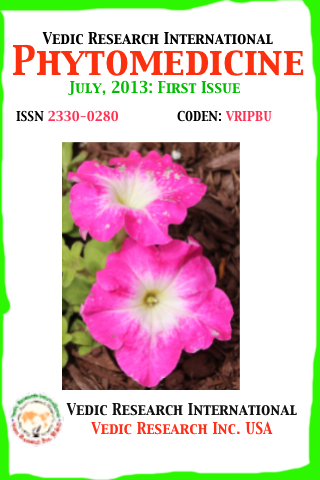
Absence of interceptive effect in female Wistar rats exposed to Jacaranda decurrens during organogenesis period
Abstract
Jacaranda decurrens subsp. symmetrifoliolata Farias and Proença (Bignoniaceae) popularly known as “carobinhaâ€, “carobinha-do-campo†or “carobaâ€Â is used in folk medicine as a blood cleanser, wound healing and to treat uterus and ovary inflammations. In order to evaluate the reproductive performance and embryotoxic effects of the Jacaranda decurrens during organogenic period, the pregnant Wistar rats received, via gavage, 27.5 mg/Kg/day of aqueous extract. The control group received only distillate water. No clinical signs of maternal toxicity were observed and the term fetuses dis not present malformations or anomalies. Our results suggest that Jacaranda decurrens aqueous extract, in these experimental conditions, seems not to cause embryo deaths, growth retardation, and/or malformations in Wistar rats.
Full Text:
PDFReferences
Rodrigues VEG, Carvalho DA: Levantamento etnobotânico de plantas medicinais no domÃnio cerrado na região do alto Rio Grande- Minas Gerais. Ciên Agrotec 2001, 25:102-103.
Mauro C, Pereira AMS, Silva CP, Missima J, Ohnuki T, Rinaldi RB: Anatomical study of species from savana-like formation, Anemopaegma arvense (Vell.) Stellf. Ex de Souza (catuaba), Zeyheria montana Mart. (bolsa-de-pastor) and Jacaranda decurrens Chamisso (caroba)-Bignoniaceae. Rev Bras Farmacogn 2007, 17:262-265.
http://dx.doi.org/10.1590/S0102-695X2007000200021
Nunes GP, Silva MF, Resende UM, Siqueira JM: Plantas medicinais comercializadas pelos raizeiros no Centro de Campo Grande, MS. Rev Bras Farmacogn 2003, 13:82-92.
http://dx.doi.org/10.1590/S0102-695X2003000200004
Carvalho CA, Lourenço MV, Bertoni BW, França SC, Pereira PS, Fachin AL, Pereira AMS: Atividade antioxidante de Jacaranda decurrens Cham., Bignoniaceae. Rev Bras Farmacogn 2009, 19:592-598.
http://dx.doi.org/10.1590/S0102-695X2009000400015
Santos JÃ, Arruda A, Silva MA, Cardosos CAL, Vieira MC, Kassuya CAL, Arena AC: Anti-inflamatory effects and acute toxicity of hydroethanolic extract of Jacaranda decurrens roots in adult male rats. J Ethnopharmacol 2012, 144:802-805.
http://dx.doi.org/10.1016/j.jep.2012.10.024
PMid:23088848
Taylor P, Arsenak M, Abad MJ, Fernández A, Milano B, Gonto R, Ruiz MC, Fraile S, Taylor S, Estrada O, Michelangeli F: Screening of Venezuelan medicinal plant extracts for cytostatic and cytotoxic activity against tumor cell lines. Phytoter Res 2013, 27: 53-539.
http://dx.doi.org/10.1002/ptr.4752
PMid:22648665
Chez RA, Jonas WB: Complementary and alternative medicine. Part I: clinical studies in obstetrics. Obstet Gynecol Surv 1997, 52:704-708.
http://dx.doi.org/10.1097/00006254-199711000-00024
PMid:9357044
Ernst E: Herbal medicinal products during pregnancy: are they safe? BJOG: an Int J Obst Gyn 2002, 109:227–235.
http://dx.doi.org/10.1111/j.1471-0528.2002.t01-1-01009.x
Ujházy E, Mach M, Navarová J, Dubovický M: Teratology on the crossroads: historical aspects and modern approaches. Neuro Endocrinol Lett 2012, 33:304-313.
PMid:22635090
Manson JM, Kang YJ: Test methods for assessing female reproductive and developmental toxicology. In Principles and methods of toxicology. Edited by Hayves, AW: New York Raven Press; 1994: 989-1034.
Mazaro R, Di Stasi, Kempinas WG: Effects of the hydromethanolic extract of Austroplenckia populnea (Celastraceae) on reproductive parameters of male rats. Contraception 2002, 66:205-209.
http://dx.doi.org/10.1016/S0010-7824(02)00342-6
Yakubu MT, Akanji MA, Oladiji AT: Evaluation of antiandrogenic potentials of aqueous extract of Chromolaena odoratum (L.) K.R. leaves in male rats. Andrologia 2007, 39: 235-243.
http://dx.doi.org/10.1111/j.1439-0272.2007.00792.x
PMid:18076423
Arena AC, Torraca JAM, Cardoso CAL, Kempinas WG, Vieira MC: Maternal exposure to aqueous extract of Jacaranda decurrens: Effect on reproductive system in male rats. Pharm Biol 2011, 50:195-200.
http://dx.doi.org/10.3109/13880209.2011.592538
PMid:22050261
Barrow MV, Taylor WI: A rapid method for detecting malformation in rat fetuses. J Morphol 1969, 127:291-306.
http://dx.doi.org/10.1002/jmor.1051270303
PMid:4388962
Wilson JG: Methods for administering agents and detecting malformations in experimental animals. In: Teratology: principles and techniques. Edited by Wilson JG, Warkany J: The University of Chicago Press; 1965:262-277.
Oliveira RJ, Oliva SU, Daroz GA, Rubio EM: Fertility assessment and possible external structural defects on progeny from male rats chronically exposed to arsenic. Rev Brasil Toxicol 2005,18:57-61.
Oliveira RJ, Sales MJS, Silva AF, Kanno TYN, Lourenço AC, Freiria GA, Matiazi H.J., Ribeiro LR, Mantovani MS: Effect of the polyssacharide β-glucon on clastogenicity and teratogenicity caused by acute exposure to cyclophosphamide in mice. Regul Toxicol Pharm 2009, 53:164-173.
http://dx.doi.org/10.1016/j.yrtph.2008.12.007
PMid:19168112
Taylor P: Pratical teratology. New York: Academic Press; 1986.
Damasceno DC, Kempinas WG, Volpato GT, Consoni M, Rudge MVC, Paumgartten FRJ: Anomalias congênitas: estudos experimentais. Belo Horizonte: Coopmed Editora Médica; 2008.
PMCid:PMC2442528
Staples RE, Schnell VL: Refinements in rapid clearing technic in the KOH-alizarin red S method for fetal bone. Stain Technol 1964, 39:61-63.
PMid:14106473
Manson JM, Zenick H, Costlow RD: Teratology test methods for laboratory animals. In Principles and methods of toxicology. Edited by Hayves, AW: New York Raven Press; 1982:141-184.
Ibarreta D, Daxenberger A, Meyer HH: Possible health impact of phytoestrogens and xenoestrogens in food. Acta Pathol Microbiol Immunol Scandinavica 2001, 109:161-184.
http://dx.doi.org/10.1034/j.1600-0463.2001.090301.x
Jefferson A: Dietary phytoestrogens-a role in women's health. Nutri Food Sci 2003, 32:16-22.
http://dx.doi.org/10.1108/00346650310459527
United State Environmental Protection Agency-US EPA: Reproductive toxicity risk assessment guidelines. In: United State Environmental Protection Agency-US EPA; 1996:56273-56322.
Guerra MO, Mazoni ASB, Brandão MAF, Peters VM: Toxicology of Lapachol in rats: embryolethality. Rev Brasi Biol 2001, 61:171-174.
http://dx.doi.org/10.1590/S0034-71082001000100021
Kalter H: The relationship between congenital malformations and prenatal mortality in experimental animals. In Human embryonic and fetal death. Edited by Potter I, E. B. Hook EB: New York Academic Press; 1980:29-44.
Auharek SA, Vieira MC, Cardoso CAC, Oliveira RJ, Cunha-Laura AL: Reproductive toxicity of Campomanesia xanthocarpa (Berg.) in female Wistar rats. J Ethopharmacol 2013, 148:341-343.
http://dx.doi.org/10.1016/j.jep.2013.04.010
PMid:23603192
Aliverti V, Bonanomi L, Giavini E, Leone VG, Mariane V: The extent of fetal ossification as na index of delayed development in teratogenic studies on the rat. Teratol 1979, 20:237-242.
http://dx.doi.org/10.1002/tera.1420200208
PMid:524298
Skakkebaek NE, Rajpert-De Meyts E, Main KM: Testicular dysgenesis syndrome: an increasingly common developmental disorder with environmental aspects. Hum Reprod 2001, 16:972–978
http://dx.doi.org/10.1093/humrep/16.5.972
PMid:11331648
Sharpe RM, Skakkebaek NE: Testicular dysgenesis syndrome: mechanistic insights and potential new downstream effects. Fertil Steril 2008, 89:33–38.
http://dx.doi.org/10.1016/j.fertnstert.2007.12.026
PMid:18308057
DOI: http://dx.doi.org/10.14259%2Fpm.v1i1.33
Refbacks
- There are currently no refbacks.






